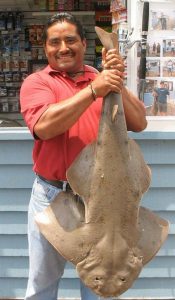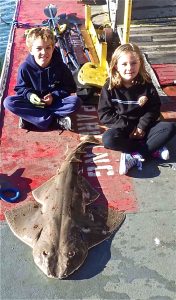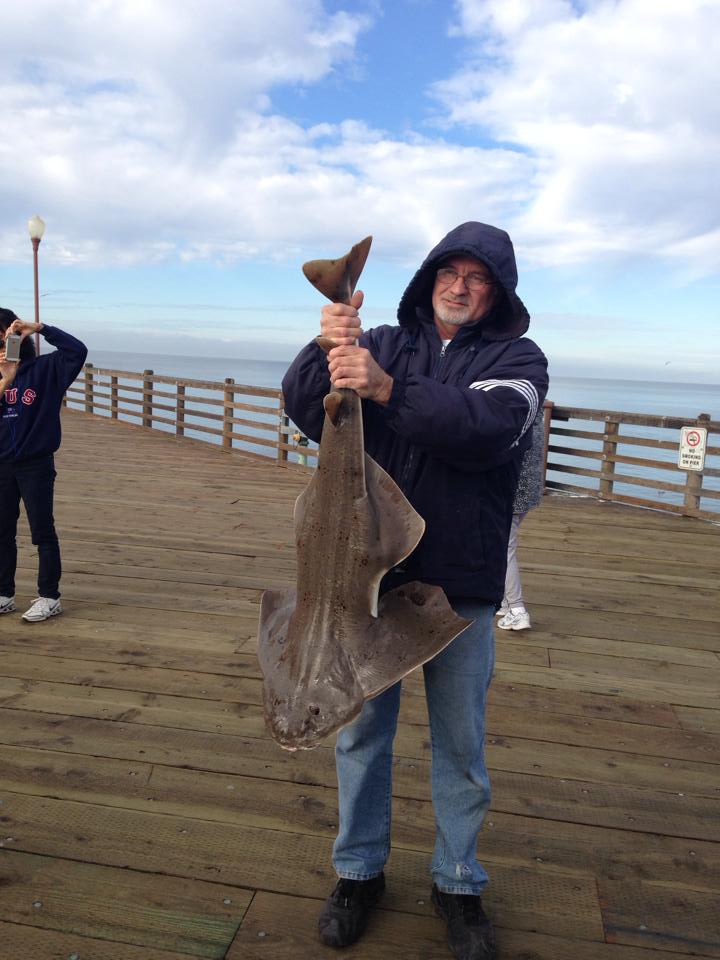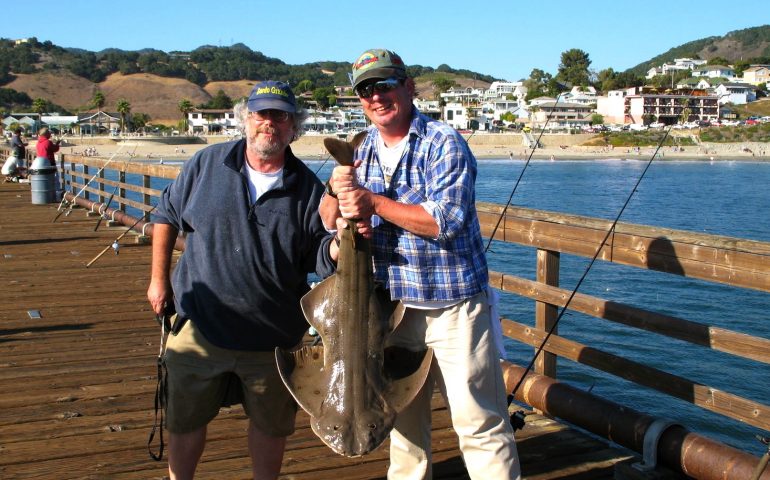Pacific Angel Sharks: Family Squatinidae
Species: Squatina californica (Ayres, 1859); from the Latin squatina (an ancient name for a related Mediterranean species) and californica (describing where the fish was first caught).
Alternate Names: Angel shark, monkfish, squat and squato. Called angelote or tiburón angel in Mexico.
Identification: These sharks look like a ray, or a cross between a shark and a ray and are often mistaken for rays by anglers. However, a couple of items gives them away: (1) angel sharks have a flattened body similar to rays but have broad pectoral fins that are unattached to the head, and (2) the mouths of angel sharks are up front of the head, not underneath as in rays. Their camouflage coloring, typically sandy gray, gray brown, or reddish with dark spots, allows them to lie relatively unnoticed on the bottom. The belly is white. Angel sharks are unique in that the lower lobe of the tail is longer than the upper lobe.
Size: Reaches a length of nearly six feet (68.9 inches) and a size of 60 pounds. Most caught from piers are under 4 feet in length.

Angel shark from the Oceanside Pier in 2012
Range: Bahía Magdalena, southern Baja California, and the Gulf of California, to Puget Sound, Washington and Clover Point, Vancouver Island. One unverified record from Alaska; rare north of California. Common from Tomales Bay south.
Habitat: Offshore and in shallow bays in sand or mud bottoms near rocky reefs. Found from surf zone down to 672 feet. Primarily feeds at night and their main foods are fish and shellfish (although they’ll settle for squid, octopi, sea cucumbers and other unusual tidbits in order to maintain a well balanced and nutritional diet). Some sources say one of their main foods is California halibut. So flatties beware! Angels are bottom lurkers and ambush predators that like to lie partially buried in the sand awaiting unsuspecting prey to wander by. When fish and other organisims, aka food, come close, angels use their protrusible and highly expandable mouths (armed with big teeth) to quickly inhale the unlucky prey. Perhaps the prey should have been praying since they don’t have a prayer of a chance.
Piers: Not common at any pier although occasionally caught. Best bets: SoCal—Ocean Beach Pier, San Clemente Pier, Hermosa Beach Pier, Santa Monica Pier, Ventura Pier; CenCal—Avila Beach Pier and, possibly the best, the Cayucos Pier.
Shoreline: Occasionally caught by anglers fishing surf areas in southern California.
Boats: Occasionally taken by boaters and kayakers in southern and central California fishing fairly shallow waters.

Angel shark from the Capitola Wharf
Bait and Tackle: Medium tackle, 30-pound or so line with size 2-4/0 hooks should suffice for these beasts.
Food Value: The flesh is considered good quality and very good eating. As a result, they have become the object of a considerable commercial fishery. The flavor is mild, the texture is firm, the flakes are large and they are moderate in fat content. Generally considered suitable for all methods of cooking.

Angel shark from the Oceanside Pier — 2014
Comments: Their name is derived from the large pectoral fins that remind many of angel wings (and how about a buffalo wing and angel wing combo plate?). As mentioned, these guys (or girls) have the nasty habit of extending out their jaws in an explosive manner to capture food and, unfortunately, quite a few anglers have been bitten by angel sharks after the fish were landed. Never stick your hand or arm near the mouth of an angel shark unless you are absolutely sure it is dead.
Although several related species in Europe are considered endangered species, the Pacific Angel Shark seems to continue to show good numbers.
Angel Sharks from piers —An uncommon shark that when caught are often good size.
65 Lbs. — Cayucos Pier, August 2004; Source: Source: Glenda, The Tidepool B&T, Cayucos
50 Lbs. — Capitola Wharf, July 1999; Source: Capitola Wharf Bait Shop
50+ Lbs. — Rainbow Pier (Long Beach), James Borchers, May 19, 1948; Source: Long Beach Independent, May 20, 1948
36 Lbs. — San Clemente Pier, April 2008; Source: PFIC
30-pound, 43-inch — Cayucos Pier, April 1997; Source: Glenda, The Tidepool B&T, Cayucos

Great read! I really enjoyed learning more about the Pacific angel shark and its unique adaptations for ambush hunting. It’s fascinating how they blend so perfectly into their sandy environments. The tips for targeting them while pier fishing were especially helpful—I’ll definitely keep an eye out for those subtle movements and sandy patches next time I’m out. Thanks for sharing such detailed and practical information!